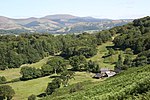Llyn Eiddwen

Llyn Eiddwen () is a lake and site of special scientific interest near Trefenter in Ceredigion, Wales. It is the source of the River Aeron. This natural lake provides an environment to preserve rare local water-plant life and seasonal animals. It is owned and managed by the Wildlife Trust of South and West Wales. Surrounded by sheep-grazed common land, it is part of a national nature reserve. Visitors come on foot from the north or on bridleways from the south.Remote and peaceful, Llyn Eiddwen National Nature Reserve lies in the gentle slopes of Mynydd Bach, to the north west of Tregaron town in Ceredigion. The wet and quiet nature of its habitats suits shy creatures such as water voles and otters. A climb to the summit of the surrounding hills reveals views of Cardigan Bay to the west, and of the Pumlumon and Elenydd uplands to the north and east.
Excerpt from the Wikipedia article Llyn Eiddwen (License: CC BY-SA 3.0, Authors, Images).Llyn Eiddwen
Geographical coordinates (GPS) Address Nearby Places Show on map
Geographical coordinates (GPS)
| Latitude | Longitude |
|---|---|
| N 52.283 ° | E -4.044 ° |
Address
SY23 4JH , Lledrod
Wales, United Kingdom
Open on Google Maps





